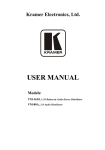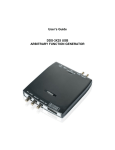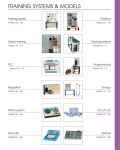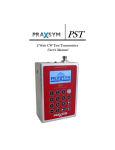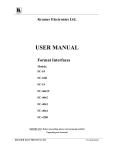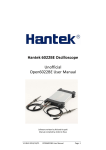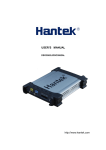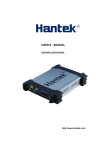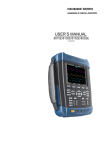Download Hantek1025G User`s Manual ARBITRARY FUNCTION GENERATOR
Transcript
User’s Manual Hantek1025G ARBITRARY FUNCTION GENERATOR www.hantek.com Content General safety summary ......................................................................................................... 1 Introduction ............................................................................................................................. 2 Chapter 1 Getting started ........................................................................................................ 3 1.1 System Requirements ............................................................................................... 4 1.2 Installing Hardware .................................................................................................... 5 1.3 Installing Software ..................................................................................................... 8 Chapter 2 Operating Basics .................................................................................................. 11 2.1 The User’s Interface ................................................................................................ 12 2.2 The Menu System ................................................................................................... 13 2.3 The Waveform Control System ................................................................................ 16 Chapter 3 Understanding Functions...................................................................................... 17 3.1 Waveform parameter ............................................................................................... 18 3.2 Waveform Output Control ........................................................................................ 19 3.3 Edition of Arbitrary Waveform .................................................................................. 20 3.4 Waveform Data Files ............................................................................................... 21 3.4 Frequency/Counter Measurement ........................................................................... 22 3.5 Digital Input/Output .................................................................................................. 23 3.6 Output without PC ................................................................................................... 26 3.7 Synchronized output ................................................................................................ 27 3.8 External Trigger Input .............................................................................................. 28 Chapter 4 Application Examples ........................................................................................... 30 4.1 Generate the Simple Waveform .............................................................................. 31 4.2 Generate Arbitrary Waveform .................................................................................. 32 Appendix ............................................................................................................................... 33 Hardware Specification .................................................................................................. 34 Cleaning and maintenance ............................................................................................ 35 Hantek1025G General safety summary Please understand the following safety precautions to avoid injuries and damages to the product or any equipment connected. To be away from possible dangers, please be sure to follow the regulations. Only qualified persons are allowed to do the maintenance. Prevent from fire and any personal damage. Use Proper Power Cord. Use the power cord authorized in your country only. Correctly Plug in and Pull out. When the probes or the test leads are connecting to the voltage source, please do not plug in or pull out. Ground the product. This product is grounded through the grounding conductor of the power cord. To avoid electric shocks, the grounding conductors must be grounded properly before making connections to the input or output terminals of the instrument. Correctly connect probe. The probes’ ground terminals are at the same voltage level of the product ground. Do not connect the ground terminals to a high voltage. Check the ratings of all terminals. To avoid fire or shock hazard, check all ratings and marks on the product. Follow the user’s guide for detailed rating information before making connections to the product. Do not operate the product when the case or panel is removed. Avoid Circuit Exposure. Do not touch exposed connections and components when power is on. If you think the product is broken, do not operate. If you think that this product has something wrong, please let qualified service persons to check it. Keep proper ventilation. Do not operate in wet/damp environment. Do not operate in flammable and explosive air. Please keep the product surface clean and dry. USER’S MANUAL 1 Hantek1025G Introduction Hantek 1025G Arbitrary Waveform Generator has one channel of arbitrary waveform output, 12 Bits output, synchronized signal outputs, 1 channels of Counter/Frequency Measurement inputs, 6 Bits input and external trigger input. User can edit the waveform arbitrarily by the mouse or choose the regular waveforms such as Sine, Square, Tri-angle, Saw-tooth, TTL, White Noise, Gauss Noise, Trapeze, Exponent, AM and FM. The parameters, such as amplitude, frequency and offset, are also settable. The data format of Hantek 1025G is completely compatible with that of Tektronix; it can directly read the waveform data files produced by the Tektronix oscilloscope or Tektronix waveform editor software and redisplay the waveform. Hantek 1025G adopts the DDS technology so that it has the advantages of high frequency accuracy, high waveform resolution, high reliability, and wide software support. It can widely use in the various kinds of electronics labs and it offers complete interface for second time development to be pointlessly inserted into other auto-measuring systems. USER’S MANUAL 2 Hantek1025G Chapter 1 Getting started This chapter focuses on the following topics: System Requirements Installing hardware Installing software USER’S MANUAL 3 Hantek1025G 1.1 System Requirements Minimum System Requirements Operating System Windows XP/Vista/Win 7 Memory 128MB Graphic Card Microsoft DirectX supported Screen resolution: 1024x768 Color depth: 16bit Recommended System Requirements Operating System Windows XP/Vista/Win 7 Memory 256MB Graphic Card Microsoft DirectX supported Screen resolution: 1024x768 Color depth: 16bit USER’S MANUAL 4 Hantek1025G 1.2 Installing Hardware 1. Connect the A-Type Plug of USB cable to your PC’s USB port. 2. Connect the B-Type Plug of USB cable to Hantek1025G’s USB port. 3. New hardware is found. 4. New hardware search wizard starts. USER’S MANUAL 5 Hantek1025G 5. Choose the correct directory of the driver through the browser or search in the CD driver. 6. New hardware wizard installs software. USER’S MANUAL 6 Hantek1025G 7. Finish new hardware search wizard. USER’S MANUAL 7 Hantek1025G 1.3 Installing Software 1. While in Windows, insert the installation CD into the CD-ROM drive. 2. The installation should start up automatically. Otherwise in Windows Explorer, switch to the CD-ROM drive and run "Setup.exe". 3. The Hantek 1025G Installation is started. Click 'Next' to continue. USER’S MANUAL 8 Hantek1025G 4. Choose a destination directory. Click 'Next' to continue. 5. Check the setup information. Click Next to start copying of files. USER’S MANUAL 9 Hantek1025G 6. This Status dialog is displayed during copying of files. 7. The installation is complete. USER’S MANUAL 10 Hantek1025G Chapter 2 Operating Basics This chapter focuses on the following topics: The User’s Interface The Menu System The Waveform Control System USER’S MANUAL 11 Hantek1025G 2.1 The User’s Interface Hantek 1025G provides users a simple and full-featured interface so that users do not have to spend a lot of time to learn. USER’S MANUAL 12 Hantek1025G 2.2 The Menu System 1. File z z z z z z z z z New: Close: Open CSV…: Save CSV…: Save CSV As…: Print…: Print Preview: Print Setup: Exit: 2. Edit z z z Points Edit: Zoom In: Zoom Out: USER’S MANUAL Create a new device Close current device Open a “CSV” file Save a “CSV” file Save a “CSV” file as other name Print the current waveform Preview the current waveform Configure the print setup Exit Hantek 1025G Draw the waveform after click the command of Arb. Zoom in the waveform. Zoom out the waveform. 13 Hantek1025G 3. Wave Parameter z z z z z Square: Ramp: Trapezia: Exponent: AM/FM: 4. Digital IO z z z Pattern Generator: Set the Digital out pin as pattern generator. Programmable Output: Set the Digital out pin as programmable output. Output Set: Show Digital out setup dialog. 5. Display z z z Background Color: XY Line Color: Curve Color: USER’S MANUAL Show square waveform. Show ramp waveform. Show trapezia waveform. Show exponent waveform. Show AM/FM waveform. Set background color. Set XY color. Set curve color. 14 Hantek1025G Set cursor color. Set the number of periods displayed. Show or hide the control panel. z z z Cursor Color: Wave Number: Show/Hide Control: 6. Utility z z Sweep: Show the sweep dialog. Open Output Power On: Save the current waveform to Hantek 1025G, and generate the waveform when the Hantek 1025G powers on. Close Output Power On: Stop generates the waveform when the Hantek 1025G powers on. z USER’S MANUAL 15 Hantek1025G 2.3 The Waveform Control System Click Menu “Display”->”Show/Hide control”, you can show or hide the waveform control panel. You can change the waveform parameter such as frequency, amplitude, Y Offset, or phase. Also, it includes the frequency/counter measurement system. USER’S MANUAL 16 Hantek1025G Chapter 3 Understanding Functions This chapter focuses on the following topics: Waveform parameter Waveform output control Edition of Arbitrary Waveform Counter/Frequency Measurement Waveform data files Digital Input/Output Output Power On Synchronized Output External Trigger Input USER’S MANUAL 17 Hantek1025G 3.1 Waveform parameter 1. Choose waveform Press down any button of certain waveform to switch to the output of such kind of waveform. When switch to arbitrary waveform from other kind of waveform, the edition work can be done on the original wave form. 2. Set waveform parameters Click Menu “Wave Parameter”, there are the choices for setting of various waveform parameters. For example: click “AM/FM” to set the AM/FM parameters in the dialog. USER’S MANUAL 18 Hantek1025G 3.2 Waveform Output Control By the following buttons to control the output dot numbers, trigger mode, output amplitude, and limit frequency of the wave filter. Single Wave: Output waveform only once. -20dB: Attenuation the waveform Ext Trig: Use the external or internal trigger system. Wave ON/OFF: Turn the waveform on/off. Ext Trig Mode: External Trigger Mode (see “External Trigger Input”). Phase: The phase of the waveform to generate. Y Offset: The offset of the waveform to generate. Frequency: The frequency of the waveform to generate (The Frequency Range is DC~75MHz when generating sine waveform, or DC~25MHz when generating other waveforms). Amplitude: The maximum voltage of the waveform to generate. USER’S MANUAL 19 Hantek1025G 3.3 Edition of Arbitrary Waveform Choose “Arb” waveform, and click the menu”Edit”->”Edit Points” to open edit points dialog. USER’S MANUAL 20 Hantek1025G 3.4 Waveform Data Files The data format of Hantek1025G is “.CSV”. Its format is compatible with the CSV file produced by the Tektronix ARB Express software. User can edit or set up the required CSV waveform and also use Excel to open and edit the CSV wave files. USER’S MANUAL 21 Hantek1025G 3.5 Frequency/Counter Measurement Click the “F/C ON/OFF” to turn on or off the frequency/counter measurement. Connect to the Frequency/Counter Measurement pin, and turn on the “F/C ON/OFF”, you can see the frequency in the edit box. Turn the left right button to “C” end, you can see the counter in the edit box. USER’S MANUAL 22 Hantek1025G 3.6 Digital Input/Output Select Menu “Digital IO”, you can change the current digital IO mode. At the digital IO terminal on the Hantek1025G, there are 20 digital IO pins, 1 GND, 1 TRIG, 1 CTRL, 1 COUNT IN, 4 Digital In Pins and 12 Digital Out Pins. 1. Pattern Generator: The vertical resolution of Hantek1025G is 12bits. If selected this mode, you can get the each bit of the value by testing the digital out pins. The LSB is O0, and OB is MSB. By Logic Analyzer, you will get a good view. For example: Use the Hantek1025G to generate a 1 KHz, 2.00V, sine waveform. Then connect the O0- OB to logic analyzer. And you will see the sine waveform on the logic analyzer. USER’S MANUAL 23 Hantek1025G 2. Programmable Output: Select menu “Programmable output”, then the Programmable output mode works. Select menu “Digital IO”->”Output set”, the “output set” dialog show. USER’S MANUAL 24 Hantek1025G By selecting one pin, that digital output pin will output high level. Otherwise, the pin will output low level. 3. Digital Input Select menu “Digital IO”->”Digital Input”, the following dialog show. If you input a high level to a digital input pin, the pin on the dialog would show H; otherwise, the pin on the dialog would show L. USER’S MANUAL 25 Hantek1025G 3.7 Output without PC Hantek1025G can save a waveform to its own memory and work without PC. Open: Select menu “Utility” -> “Open output power on”. Then the current waveform will be saved to hardware. And the waveform will be generated every time when you connect the Hantek 1025G to power. The Hantek 1025G is powered by USB. Close: If you want to clear the waveform from the hardware memory, select “Close Output Power On”. If you don’t want to generate the waveform which is saved in the hardware memory, connect the “CTRL” pin end to ground before inputting power to this instrument. USER’S MANUAL 26 Hantek1025G 3.8 Synchronized output If you generate a waveform by software, there is a synchronized signal output from “SYNC” terminal. The signal is square waveform, the frequency of which is equal to the waveform you generated. For example, if you generated a 1 KHz, sine waveform, you will also generate an 1 KHz, square waveform simultaneously. The waveform on CH1 is the sine waveform you generated from the “OUTPUT” BNC terminal, and that on CH2 is the synchronized signal from “SYNC OUT” BNC terminal. USER’S MANUAL 27 Hantek1025G 3.9 External Trigger Input Also, you can use the external trigger input to control the Hantek 1025G. For example, the instrument generated a waveform, and you got a waveform on oscilloscope. Then, click the “Ext Trig” button on the interface of the software. The waveform on the oscillograph disappeared. Now the instrument use the external trigger system, but there is no external signal input, so the instrument stops to output waveform. USER’S MANUAL 28 Hantek1025G Click the “Ext Trig Mode “to switch the external trigger mode between “Fall” and “Rise”. Select the Fall mode as example. Input a signal which has fall edges to the “TRIGIN” pin terminal. When the Hantek 1025G gets to the fall edge of the external signal, it begins to generate waveform. USER’S MANUAL 29 Hantek1025G Chapter 4 Application Examples This chapter focuses on the following topics: Generate the simple waveform Generate Arbitrary Waveform USER’S MANUAL 30 Hantek1025G 4.1 Generate the Simple Waveform To generate a simple waveform, please do these steps as follows: 1. 2. 3. 4. 5. Open the software. Choose the waveform type in the right control panel. Move your mouse to the waveform screen. Press the mouse left button and move, draw your own waveform. Then you can see your own waveform in the oscilloscope. USER’S MANUAL 31 Hantek1025G 4.2 Generate Arbitrary Waveform To generate a arbitrary waveform, please do these steps as follows: 1. 2. 3. 4. 5. Open the software. Choose the “Arb” waveform in the right control panel. Move your mouse to the waveform screen. Press the mouse left button and move, draw your own waveform. Then you can see your own waveform in the oscilloscope. 6. 7. Click “Edit”->”Edit Points”, you can change the voltage of each point. Click “Edit”->”Zoom In” or “Zoom Out”, you can zoom in or out the waveform screen. USER’S MANUAL 32 Hantek1025G Appendix Hardware specification Cleaning and Maintenance USER’S MANUAL 33 Hantek1025G Hardware Specification Waveform Output Channel Frequency Range 1Hz(DC)~25MHz Frequency Resolution 0.1% DAC Clock 2K~200MHz adjustable Channels 1CH waveform output Memory Depth 4KSa Vertical Resolution 12 Bits Stability <30ppm Amplitude ±3.5V Max. Output Impedance 50 Ω Output Current 50mA Ipeak=100mA System BW 25M Harmonic Wave distortion -50dBc(1KHz), -40dBc(10KHz) Frequency Counter Channel Range DC~50MHz Input Amplitude 400mVpp~18Vpp Coupling Mode DC Accuracy ±Time Base Error ±1 Count Input Impedance > 100KΩ Digital Input and Output 12 Bits Output 6 Bit Input Level 12 Bits Digital Generator and GO 6Bit GI LVCMOS Working Environment Working Temperature 0~70 Centigrade Working Humidity 0~95% Weight 300g USER’S MANUAL 34 Hantek1025G Cleaning and maintenance Cleaning In order to maintain the cleanliness of equipment, you need to check whether the channels are dusty or not. Please clean the out surface of the equipment follow these matters. 1. Use velvet cloth contact the surface of the equipment. 2. Pease do not use any corrosive or chemistry. Caution Please make sure the equipment is dry enough before going to work. Avoid mangling the equipment or hurting body because of water! In order to not mangle the equipment, you should not put it in fog, water or impregnate. Maintenance Don’t put the equipment under the sun for a long time. Put it in wind to the best of one's abilities USER’S MANUAL 35






































